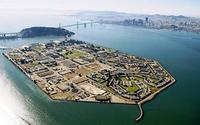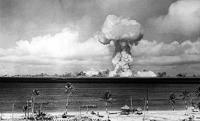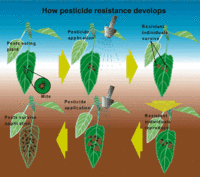-
New technique allows better monitoring of water quality
Researchers have developed a new technique that uses existing technology to allow researchers and natural resource managers to collect significantly more information on water quality to better inform policy decisions. In addition to its utility for natural resource managers, the technique will also allow researchers to develop more sophisticated models that address water quality questions.
-
-
Radiation problems on San Francisco’s Treasure Island persist

The Army Corps of Engineers created San Francisco’s Treasure Island for the 1939 Golden Gate International Exposition, with plans to turn the island into a civilian airport after the exposition. When the United States entered the Second World War in 1941, the Navy used the island for the Treasure Island Naval Station, where nuclear war training exercises were conducted. The Naval Station was decommissioned in 1993, and parts of the island were transferred to SF for civilian use. Radiation levels on the island are still high, however, and critics charge that the Navy did not do enough to clean the island while downplaying the risks of radiation that still remain.
-
-
Employees exposed to radiation at nuclear waste disposal site
Thirteen employees at the Waste Isolation Pilot Plant(WIPP),a nuclear waste burial site in New Mexico, have been exposed to radioactive radiation after a leak in one of WIPP’s underground tunnels. Energy Department officials say it is too soon to determine the scope of health risks the employees will deal with. The employees inhaled plutonium and americium, both of which can irradiate the body’s internal organs with subatomic particles for a lifetime.
-
-
Islanders’ radiation worries 60 years after Bikini Atoll atomic test

Sixty years ago, On 1 March 1954 the United States tested a 15-megaton hydrogen bomb – a thousand times more powerful than the bomb dropped on Hsroshima —- at Bikini Atoll, part of the Marshall Islands. The explosion vaporized one island, and exposed inhabitants on neighboring islands to radioactive fallout. The United States relocated many of the islanders and spent years – and more than $45 million – to clean up and decontaminate the islands, before allowing the relocated inhabitants to return. Many were forced to leave again, however, after they were found to be exposed to residual radiation. From 30 June 1946 to 18 August 1958, the United States conducted 67 atmospheric nuclear tests in the Marshall Islands.
-
-
Operator of Hanford nuclear disposal site fires scientists who voice safety concerns
The Hanford project in Washington State is the Department of Energy’s (DoE) largest nuclear cleanup project. DoE plans to transform fifty-six million gallons of radioactive sludge, currently stored in underground tanks, into solid glass. Scientists and engineers who work at Hanford have questioned the effectiveness of the required technology, and have voiced serious concerns about safety issues. Two of those who were the most persistent in voicing their concerns about safety have been fired, and a third one has left his job voluntarily.
-
-
Positive safety results Marburg drug candidate announced
Marburg hemorrhagic fever is a severe and potentially fatal disease in humans first recognized in 1967. It is caused by an RNA virus of the Filoviridae family and is understood to be endemic to Africa. The Marburg virus is classified as a Category A bioterrorism agent by the Centers for Disease Control and Prevention (CDC), and in 2006 was determined by DHS to be a material threat to national security and public health. There are currently no treatments for Marburg virus infection beyond supportive care. Cambridge, Massachusetts-based Sarepta Therapeutics, a developer of innovative RNA-based therapeutics, announced positive safety results from a Phase I multiple ascending dose study of AVI-7288 in healthy volunteers. AVI-7288 is the company’s lead drug candidate for the treatment of Marburg virus infection.
-
-
25 children in California stricken with polio-like illness
Twenty-five children in California have been exhibiting a “polio-like syndrome,” leading to paralysis in one or more of their limbs. “What’s we’re seeing now is bad. The best-case scenario is complete loss of one limb, the worst is all four limbs, with respiratory insufficiency, as well. It’s like the old polio,” say a a pediatric neurologist. Scientists say that samples from two of the children tested positive for enterovirus 68, a rare virus linked in the past to severe respiratory illness.
-
-
Not much is known about long-term health effects of chemical leaked in W.Va.
In January, 10,000 gallons an obscure chemical called 4-methylcyclohexanemethanol, or MCHM, used in processing coal, leaked from storage tanks into the nearby Elk River in the Charleston, West Virginia area, contaminating the water of more than 300,000 residents for days. To what degree MCHM affects long-term human and fetal health is a major concern for residents because of the lack of complete toxicology and other studies on the chemical.
-
-
Aircraft used in Vietnam source of postwar Agent Orange contamination in U.S.

During the Vietnam War, in an operation called Operation Ranch Hand, approximately twenty million gallons of herbicides, including around 10.5 million gallons of dioxin-contaminated Agent Orange, were sprayed by about thirty-four C-123 aircraft. These aircraft were subsequently returned to the United States and were used by Air Force reserve units between 1971 and 1982 for transport operations. Air Force reservists who flew these planes were exposed greater levels of dioxin than previously acknowledged.
-
-
Visually displayed early warning system for epidemics
Cholera has been all but eradicated in Europe, but this bacterial, primarily waterborne disease still claims thousands of lives in Africa every year. In an EU-funded project, scientists are examining the effects various environmental factors have on cholera epidemics in Uganda, and have developed a software architecture for early warning systems that compares environmental and health data and presents the results graphically, allowing for the creation of visually displayed early warnings of epidemic breakouts.
-
-
Uncovering drug resistance mechanism to help development of antibiotic drug candidates
The use of antibiotics is often considered among the most important advances in the treatment of human disease. Unfortunately, though, bacteria are finding ways to make a comeback. More than two million people in the United States come down with antibiotic-resistant infections annually, and at least 23,000 die because their treatment cannot stop the infection. A new study has uncovered a mechanism of drug resistance. This knowledge could have a major impact on the development of a pair of highly potent new antibiotic drug candidates.
-
-
Superbugs presence increases during annual pilgrimage to India’s sacred sites

The spread of antibiotic-resistance to one of the most pristine locations in Asia is linked to the annual human pilgrimages to the region, new research has shown. The researchers have found that in May and June, when hundreds of thousands of visitors travel to Rishikesh and Haridwar to visit sacred sites, levels of resistance genes that lead to “superbugs” were found to be about sixty times greater than other times of the year. They argue that preventing the spread of resistance genes that promote life-threating bacteria could be achieved by improving waste management at key pilgrimage sites.
-
-
Solution to drug resistance problem receives U.S. patent
Before the development of penicillin, people dropped like flies in response to minor infections. Even pimples could grow to boils that killed. One of the main killers prior to the discovery of antibiotics was tuberculosis. The deadly infectious disease that typically affects the lungs has returned – and has developed a resistance to the majority of antibiotics that would otherwise kill the tuberculosis bacteria. A Danish chemistry researcher has taken out a patent for a drug that can make previously multidrug-resistant bacteria once again responsive to antibiotics.
-
-
Gaining better understanding of tularemia, aka “rabbit fever”
Tularemia, aka “rabbit fever,” is endemic in the northeastern United States, and is considered to be a significant risk to biosecurity — much like anthrax or smallpox — because it has already been weaponized in various regions of the world. Despite its importance for both public health and biodefense, F. tularensis pathogenesis is not entirely understood, nor is it fully understood how the organism persists in the environment.
-
-
Resistance shapes the discovery of new insecticides

Recent news around the world has focused on the dangers of antibiotic resistance. – and the CDC estimates over two-million illnesses and 23,000 deaths occurred in 2013 as a result of antibiotic resistance in bacteria and fungus. But what of another type of resistance which can also have a huge impact on the population: that to insecticides? Livestock, for example, are affected by buffalo flies; farmers and customers are familiar with the total devastation caused by fruit flies; malaria mosquitoes and bed bugs are becoming more resistant to existing chemicals. Even our pets are affected: fleas and ticks are continuing their march, leading to a need for newer, often more expensive synthetic chemistries. The price of insecticide resistance — in the form of R&D costs for new compounds — is passed from chemical companies, to farmers, to consumers.
-
More headlines
The long view
Ransomware Attacks: Death Threats, Endangered Patients and Millions of Dollars in Damages
A ransomware attack on Change Healthcare, a company that processes 15 billion health care transactions annually and deals with 1 in 3 patient records in the United States, is continuing to cause massive disruptions nearly three weeks later. The incident, which started on February 21, has been called the “most significant cyberattack on the U.S. health care system” by the American Hospital Association. It is just the latest example of an increasing trend.
